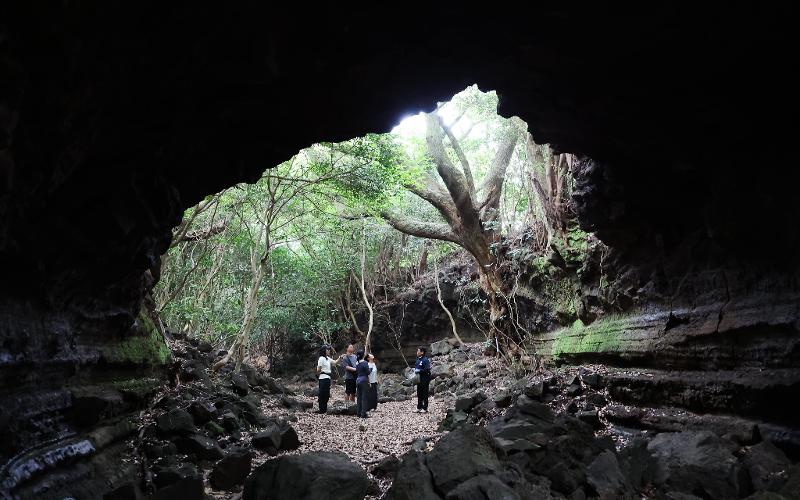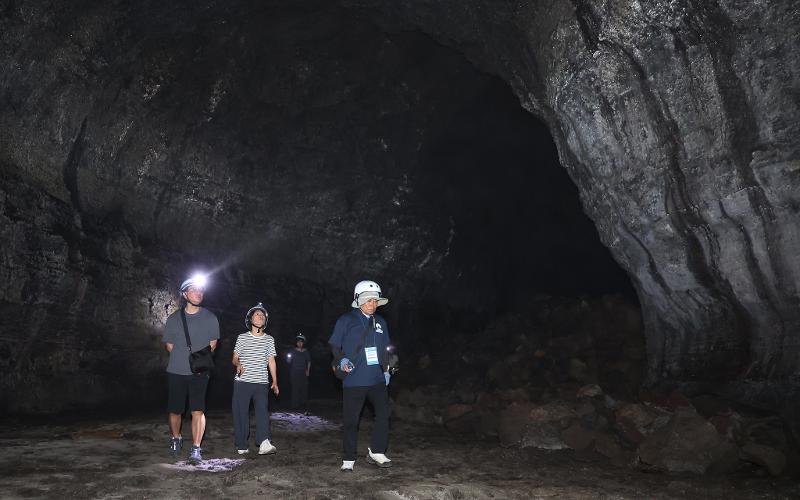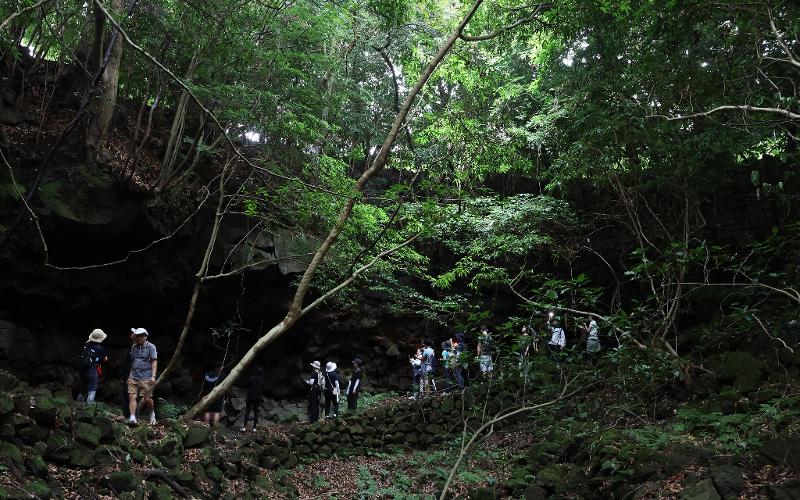The World Heritage Festival features programs promoting the outstanding universal value of world heritage to visitors from all over the world. Organized by the Korea Heritage Service and hosted by the Korea Heritage Agency, the event is being held this year at Jeju Volcanic Island and Lava Tubes on Jeju Island; Gochang Dolmen Site and tidal flats in Gochang-gun County, Jeollabuk-do Province; Gyeongju Historic Area in Gyeongju, Gyeongsangbuk-do Province; and Seonamsa Temple in tidal flats around Suncheon, Jeollanam-do Province, in that order. Korea.net begins its coverage with the first event on Jeju Island.

The World Heritage Festival kicked off on July 4 on Jeju Island, with a variety of sights and experiences such as walking programs, two exploration programs, nightscape tour, hikes along Hallasan Mountain and stories from heritage towns. Shown are visitors in the second exploration program on July 9 listening to a guide under Yongamgyo Bridge in Jeju.
By Kim Seon Ah
Photos = Park Daejin
Jeju Volcanic Island and Lava Tubes on Jeju Island are a living, breathing space showing Earth's natural formation process. UNESCO designated both sites World Natural Heritage for their high scenic value and distinct geological environment.
Beginning on July 4 in Jeju, the World Heritage Festival under the theme "Era of Succession" highlights the value of such heritage and importance of its preservation. Its leading programs include walking tours, two expeditions, starlight mountain events, treks along Hallasan Mountain and stories from heritage towns.
Korea.net participated in the second expedition and the Path of Lava walk, which involved strolling at an underground world created by volcanic activity.
The walking tour of Geomunoreum Volcanic Cone has a guide explaining the cone's formation process and a full-body experience by visitors of the mystery of the venue. The event's sections are "Path of Lava," a gargantuan valley formed by flowing lava; "Path of Caves," an underground passage made by hardened lava; and "Path of Stone and New Life," which follows the traces of lava spreading toward the sea.

Members of the second expedition on July 9 walk inside Gimnyeonggul Cave on a guided tour.
The second expedition on July 9 saw members pass through Utsanjeon Cave, Yongamgyo Bridge and Bugoreum Cave while going to Gimnyeonggul Cave. The latter is the main cave of Geomunoreum Volcanic Cone, a World Natural Heritage site shaped like the letter "S," about 705 m long and once connected to Manjanggul Cave before the ceiling collapsed.
The entrance to Gimnyeonggul, a massive arch 12 m high and 4 m wide, is an archetypal example of a tunnel-like cave formed as hot lava quickly cooled.
Like a living textbook on geology, the interior has waterfall-shaped terrain and sand and carbonate deposits formed as lava cooled and solidified in the process of flowing.

Visitors on the "Path of Lava" walking tour on July 10 walk along the lava-created terrain.
The three-hour Path of Lava walking tour on July 10 began at the World Natural Heritage Center and passed through charcoal kiln sites, lava collapse ditches and wind holes going toward Utsanjeongul Lava Tube. As the most intense of all the walking tours, this one was designed to allow visitors to see traces of volcanic activity in the huge canyon.
Participants learned about the formation of Jeju's lava cone system by walked on the rugged basalt terrain and vivid traces of the eruption of Geomunoreum Volcanic Cone. Human history and nature's mysteries intersected here and there like the kiln sites and wind holes, and the tour guide's commentary added to this experience.
Upon reaching the final destination of Utsanjeongul, the tour group was left in awe after seeing the colossal cave entrance formed by the collapsed ceiling and peculiar lava formations. Entry into the cave is prohibited, but the spectacular view from outside enable them to feel the wonders of lava caves around Geomunoreum.
"It felt like I went back in time hidden underground," tour member Kim Yun Kyu said afterward. "I have unforgettable memories of walking through places I would've never gone to if it weren't for the World Heritage Festival."
"I realized anew just how special Jeju's natural heritage is," fellow member Wang Seon Woo said. "I think we should properly preserve our beautiful World Natural Heritage sites."
The festival ends on July 22. More information on the schedule is on the event's official website (https://worldheritage.kr).
sofiakim218@korea.kr